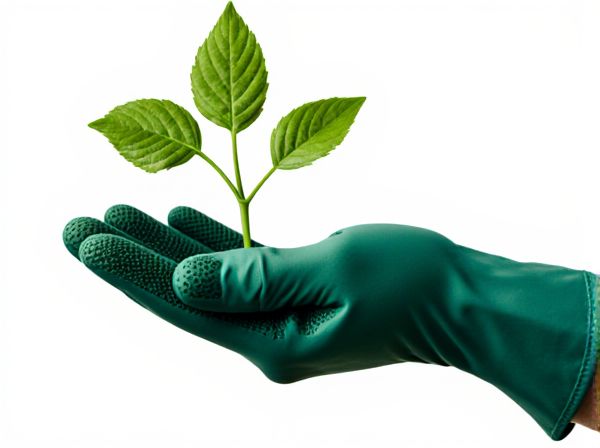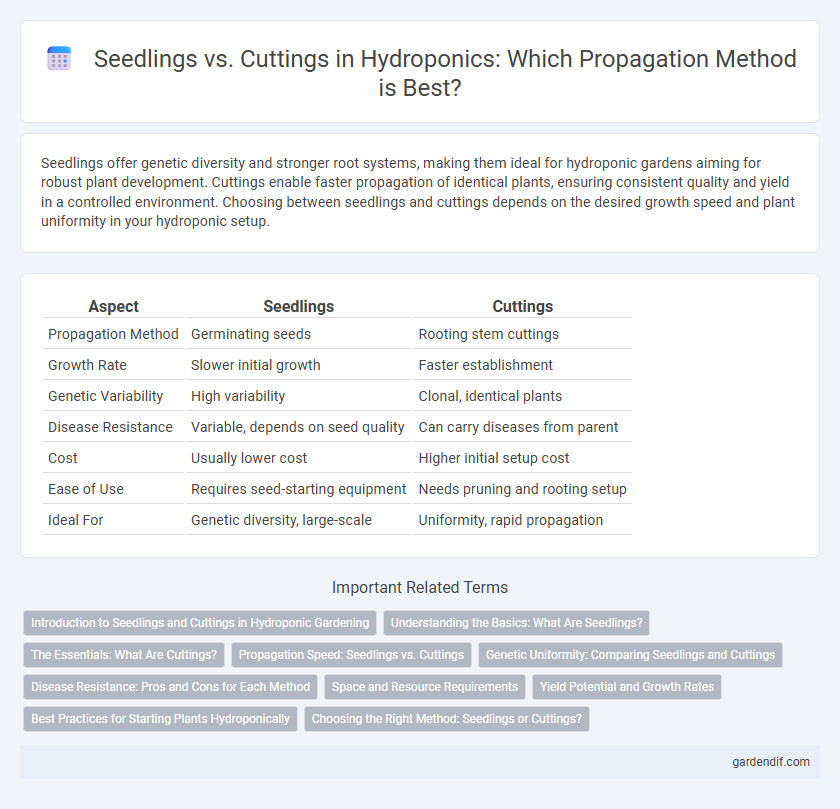
Seedlings vs Cuttings Illustration
Seedlings offer genetic diversity and stronger root systems, making them ideal for hydroponic gardens aiming for robust plant development. Cuttings enable faster propagation of identical plants, ensuring consistent quality and yield in a controlled environment. Choosing between seedlings and cuttings depends on the desired growth speed and plant uniformity in your hydroponic setup.
Table of Comparison
| Aspect | Seedlings | Cuttings |
|---|---|---|
| Propagation Method | Germinating seeds | Rooting stem cuttings |
| Growth Rate | Slower initial growth | Faster establishment |
| Genetic Variability | High variability | Clonal, identical plants |
| Disease Resistance | Variable, depends on seed quality | Can carry diseases from parent |
| Cost | Usually lower cost | Higher initial setup cost |
| Ease of Use | Requires seed-starting equipment | Needs pruning and rooting setup |
| Ideal For | Genetic diversity, large-scale | Uniformity, rapid propagation |
Introduction to Seedlings and Cuttings in Hydroponic Gardening
Seedlings in hydroponic gardening are young plants started from seeds in a controlled, soil-free environment that promotes rapid root development and healthy growth. Cuttings involve propagating new plants from a section of an established parent plant, often ensuring genetic consistency and faster maturity compared to seedlings. Both methods optimize growth cycles in hydroponics by leveraging nutrient-rich water solutions and precise environmental control.
Understanding the Basics: What Are Seedlings?
Seedlings are young plants grown from seeds that develop roots, stems, and leaves during the initial growth stages in hydroponic systems. These early-stage plants offer genetic diversity and stronger root development compared to cuttings, which are cloned segments of a mature plant. Understanding seedling growth is crucial for optimizing nutrient delivery and environmental conditions to ensure healthy plant development in soilless cultivation.
The Essentials: What Are Cuttings?
Cuttings in hydroponics are young plant segments, typically stems or leaves, that are removed from a parent plant to grow new roots independently. This propagation method ensures genetic consistency and faster establishment compared to seedlings, which originate from seeds requiring germination and early growth stages. Utilizing cuttings accelerates crop cycles and often yields higher success rates in controlled hydroponic environments.
Propagation Speed: Seedlings vs. Cuttings
Cuttings generally propagate faster than seedlings in hydroponic systems, as they are clones of mature plants and bypass the germination stage. Seedlings require more time to develop roots and grow strong enough for transplantation. Choosing cuttings accelerates the overall growth cycle, enabling quicker crop turnover and higher productivity.
Genetic Uniformity: Comparing Seedlings and Cuttings
Cuttings offer superior genetic uniformity as they are clones of the parent plant, ensuring consistent crop traits and quality in hydroponic systems. Seedlings, derived from seeds, exhibit greater genetic variation, which can result in diverse plant characteristics and unpredictable yields. This uniformity in cuttings minimizes variability, benefiting commercial hydroponic growers aiming for standardized production.
Disease Resistance: Pros and Cons for Each Method
Seedlings in hydroponic systems generally exhibit stronger disease resistance due to their genetically diverse root systems and early exposure to controlled environments, reducing pathogen susceptibility. Cuttings, while enabling rapid plant replication and genetic consistency, often inherit diseases from the parent plant, increasing vulnerability to pathogens if not properly treated. Implementing sterilization protocols and monitoring nutrient solutions are crucial for minimizing disease risks in both propagation methods.
Space and Resource Requirements
Seedlings require more space and nutrients initially as they develop roots and foliage, demanding dedicated trays and consistent nutrient solutions in hydroponic systems. Cuttings take up less space because they are smaller and primarily focused on root development, making them more resource-efficient for rapid propagation. Efficient hydroponic setups optimize water, light, and nutrient delivery to support the differing growth stages of seedlings and cuttings, maximizing space usage.
Yield Potential and Growth Rates
Seedlings in hydroponic systems offer strong root development and genetic stability, leading to consistent yield potential, while cuttings provide faster growth rates due to established root systems, accelerating the production cycle. Hydroponic cuttings often result in higher overall yields within shorter time frames by bypassing the germination phase, enhancing crop turnover efficiency. Choosing between seedlings and cuttings depends on balancing growth speed with long-term yield goals in controlled hydroponic environments.
Best Practices for Starting Plants Hydroponically
Seedlings provide a strong root system ideal for hydroponic setups, enabling faster establishment and improved nutrient uptake compared to cuttings. Cuttings can be propagated quickly and maintain the genetic traits of the parent plant, but require controlled humidity and rooting hormones to succeed hydroponically. Maintaining sterile environments and optimal water pH between 5.5 to 6.5 enhances successful development for both seedlings and cuttings in hydroponic systems.
Choosing the Right Method: Seedlings or Cuttings?
Choosing between seedlings and cuttings in hydroponic systems depends on factors like growth speed, genetic consistency, and disease resistance. Seedlings offer genetic diversity and strong root development but generally take longer to mature, while cuttings provide a faster, cloned growth cycle with uniform traits ideal for commercial production. Evaluating plant species compatibility, system design, and production goals ensures the optimal propagation method for maximizing yield and quality.
Seedlings vs Cuttings Infographic

 gardendif.com
gardendif.com